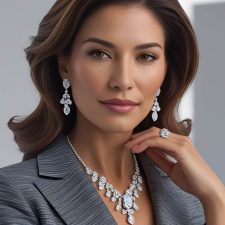Powerful women don’t just speak volumes with their actions—they communicate just as much through what they wear. Whether in tech boardrooms, political arenas, fashion houses, or academic stages, style has become a silent yet strategic tool of influence.
Across industries, these women aren’t just dressing for trends. They’re curating intentional wardrobes that reflect identity, credibility, and authority. Let’s explore the style codes that define today’s most impactful leaders.
Style as Nonverbal Communication
Before a word is spoken, style communicates tone, values, and confidence. From the crisp tailoring of finance executives to the fluid silhouettes of creative directors, outfit choices frame the message being delivered.
This is especially crucial for women who lead in male-dominated environments. A structured coat, a standout accessory, or a monochrome palette becomes armor. It commands attention without distraction and creates a presence that’s both elegant and authoritative.
Working with a luxury personal shopper helps many leaders refine this presence. These stylists offer more than shopping advice, they provide clarity, direction, and alignment with a professional image.
Industry-Specific Power Dressing
Each sector has its own visual language. In politics, it’s often solid colors, modest tailoring, and a strong sense of composure. In fashion, risk-taking is rewarded, with bold silhouettes, unexpected layering, and dramatic accessories. In tech, comfort blends with modern minimalism, sleek trousers, smart sneakers, and oversized blazers are common.
Rather than conforming, powerful women tailor these codes to their identity. A female CEO in engineering may favor sleek jumpsuits and chunky jewelry, while a founder in wellness might lean into organic fabrics and neutral tones.
No matter the field, what unites these women is not what they wear, but why they wear it.
The Role of Color
Color psychology plays a huge role in nonverbal perception. Power women know this and use it to their advantage.
Reds suggest leadership and visibility. The Navy communicates trust. Black offers elegance and edge. Neutrals exude calm authority. But understanding which shades work for your skin tone is just as essential as knowing their psychological impact.
That’s why many professionals begin their wardrobe journey with a colour analysis quiz. This simple tool determines your ideal palette, ensuring your clothing enhances both your natural features and your professional goals.
Building a Signature Look
One thing high-achieving women across industries often share? A signature style. Think of icons like Christine Lagarde, Amal Clooney, or Michelle Obama. Their outfits may evolve, but their core style DNA remains consistent.
This is the art of brand building through clothing. A signature look can be built with five to seven foundational pieces, tailored suits, silk blouses, statement coats, or bold eyewear that repeat with variation and intent.
This consistency not only simplifies dressing but also reinforces credibility. People trust what they recognize.
Investing in Quality Over Quantity
Fast fashion isn’t part of the wardrobe conversation for women who lead. They invest in fewer but better pieces that last, flatter, and feel luxurious.
That often means shopping for luxury brands that align with their lifestyle, ethics, and long-term value. Whether it’s a handcrafted handbag, a timeless coat, or Italian-made loafers, each item earns its place and stays in rotation for years.
The idea is not to be lavish but to be intentional. It’s the strategy of longevity, refinement, and self-respect.
Style as Strategy, Not Surface
It’s a misconception that caring about style is shallow. For powerful women, it’s simply another area of leadership. Clothing choices become strategic tools to influence, connect, and express leadership values.
When entering rooms where decisions are made, appearance is a part of the dialogue. It supports presence. It enhances the voice. And when done well, it shifts how others respond before a word is spoken.
Final Thoughts
Across industries, powerful women are reclaiming fashion as a vehicle of expression, not vanity. Through structure, color, intention, and subtle strategy, their wardrobes reflect the clarity of their mission.
Whether building empires or leading movements, they dress not to impress, but to express and it makes all the difference.



